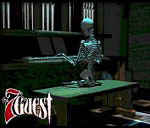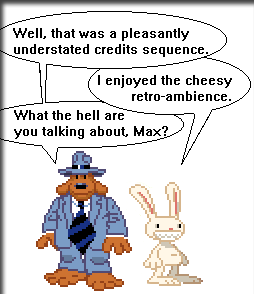
After years of pretending that newer and better consoles didn't exist, Nintendo finally released the 16-bit Super Nintendo in 1991. With its launch title, Super Mario World, it was clear that music synthesis had evolved greatly since the NES. Gamers were treated music as complex as that found on the PC, but with sound quality better than any of the mass-market soundcards. Full orchestral scores were now possible, with no loss of tracks when the action became intense.
Actraiser, released in late 1991, set a new standard for video game music, and remains in my mind as the best soundtrack ever composed for the SNES. While most other games still employed cookie-cutter variations on old arcade standards, the music in Actraiser was a unique blend of rock, classical, and techno elements. One of the most attractive tunes was from a late stage in the game  (MP3, 1.2MB). After multiple levels of constant arcade action and pumping beats, the music of the snowy wastes in Northwall is forlorn and wistful. At first, the music seems at odds and completely out of place with the action on-screen, but it ends up working better than any rock theme could have in the same setting.
(MP3, 1.2MB). After multiple levels of constant arcade action and pumping beats, the music of the snowy wastes in Northwall is forlorn and wistful. At first, the music seems at odds and completely out of place with the action on-screen, but it ends up working better than any rock theme could have in the same setting.
The Super Nintendo was also responsible for creating the genre of music dubbed "Japanese Jazz" by some. These tunes tended to be upbeat caricatures of American styles and forms, as if Japanese developers were writing music that gamers would be familiar with, while not being completely comfortable with it themselves. It was like an English poet writing his first works directly in French; the music wasn't bad at all, just unique and not quite familiar. A good example of this is an overworld theme from Super Mario World, which is probably the only action game theme to employ faux ragtime played with a honky-tonk piano patch  (MP3, 640KB).
(MP3, 640KB).
In the PC world, gamers were confronted with a smorgasbord of proprietary standards and competing synthesis methods among different soundcards. Besides the MIDI standard used by Ad-Lib and Roland, which used note-by-note instructions on how to recreate a song (akin to sheet music for a computer), the Gravis Ultrasound entered the fray by supporting the Tracker standard, which focused on the quality of the sounds used. This resulted in better sounding music, but forced every song to also include all the sounds it needed to play. To add to the confusion, Creative Labs (which was now the dominant market force) would occasionally modify its architecture slightly, keeping competitors on their toes and preventing third-party soundcards from truly being "Sound Blaster compatible".
The biggest complaint about MIDI by game composers and electronic musicians was the lack of standards. A song written for a Roland MT-32 might sound horrible on another soundcard, because the ID numbers for each instrument could vary from card to card. For example, Instrument #1 on the MT-32 might be a grand piano, but the poor gamer who bought a lesser known soundcard might hear an accordian instead when he played the song.
The General MIDI standard solved many of these problems. Most important for game composers, the ordering of 128 main instruments were standardized across all cards. Although there was no control over the quality of the sound, or patch, used in a card, gamers could at least be ensured of a reasonable facsimile of the music, and the grand piano would always be instrument #1.
General MIDI really came out of its shell in 1993, at about the same time that double-speed CD-ROM drives were hitting the market. One of the first games to really take advantage of CD-ROM was the puzzlefest, 7th Guest, by Virgin Interactive. Though it wasn't necessarily the best game ever, it had great graphics and music, and sold CD-ROM drives by the hundreds. The music for the 7th Guest was composed by George Sanger, known as the "Fat Man" in the gaming world. His name is hidden in the credits of many games, including several from the Ultima series.

The amount of data that could fit on a CD was about 600 times greater than floppy disks. Budget-strapped companies who worried over whether their game would ship on 23 or 24 disks the year before now sought ways to fill up this extra leg-room. Usually this was accomplished by creating "shovelware", or shoveling tons of ancient games onto the CD and calling it a historical collection. With its game, Sam and Max Hit the Road, LucasArts decided to use that space to the advantage of the gamer.
Since one of the biggest limitations of soundcards was the great discrepancy in sound quality between Roland and the mass-market varieties, most gamers never really heard game themes as the composer heard them. LucasArts solved this problem by recording the game's major themes as played on a Roland module, and then storing them on the CD as extra tracks.  (MP3, 657KB). When those themes arrived in the game, the CD would play, instead of the MIDI music. The jump in sound quality of this method would eventually lead to use of CD audio as a replacement for MIDI music. Sam and Max Hit the Road was also one of the funniest computer games of all time, but the topic of good games will probably fill up its own Special Week sometime in the future.
(MP3, 657KB). When those themes arrived in the game, the CD would play, instead of the MIDI music. The jump in sound quality of this method would eventually lead to use of CD audio as a replacement for MIDI music. Sam and Max Hit the Road was also one of the funniest computer games of all time, but the topic of good games will probably fill up its own Special Week sometime in the future.
The use of General MIDI as a viable music format probably peaked with the music in Origin's Ultima VIII in 1994. Although much of the soundtrack was ambient sound effects, songs like the theme from Tenebrae capture the mood of the game perfectly  (MP3, 344KB).
(MP3, 344KB).
Tomorrow: Sampled Music, Commercialization, and Game Music as a Legitimate Art Form
|
tagged as
music,
games
|
permalink
| 0 comments
|
|
|
Previous Post: Untitled Post |
Next Post: Untitled Post |
You are currently viewing a single post from the annals of URI! Zone history. The entire URI! Zone is © 1996 - 2024 by Brian Uri!. Please see the About page for further information.
